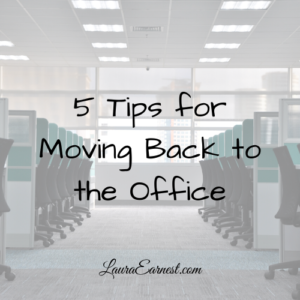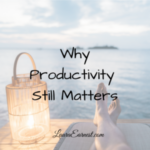As we start to reemerge after the quarantine, many of us are headed back to the office. But after working remote for so many weeks, it’s hard to think about going back to the way we were.
Today I offer some tips for those of us who are lucky enough to still be employed to keep your productivity up as you move back to the office.
1. Reduce Your Overtime
I know a lot of people are facing unemployment and involuntary reduction in hours. And it may seem that if we work longer and harder, this won’t happen to us. That’s doubtful. People are being cut because of reduced demand, and it has little to do with productivity.
However, working too many hours is actually counter-productive, leading to mistakes.
It’s been easy to work more when working from home. After all, it’s right there, all the time. We may be working a little (or a lot) more just to get a bit more time.
Remember, work expands to fill available time. Give it more time, and there will always be more work. If you’re not getting paid for it, why do it?
2. Work Distraction Free
I know I am getting a whole lot more done without my coworkers doing the gopher trick and sticking their heads above the cubes to ask me questions. At home they have to call me, or use IM. And I will turn my IM to busy and ignore my phone and let all those messages pile up.
It’s not going to be easy to continue at the office. I know I will be using my headphones more and turning off IM when I am deep in something.
3. Have Set Email Times
This is a tricky one. If my email is open, I will check it frequently. This is very disruptive when I am trying to concentrate on new development.
While working, email is open all the time so that I get the links for Zoom meetings popped up. In addition, I have my company email open, because I run Zoom through my company machine rather than my client machine. So two email systems open always in order to prompt me for meetings. That’s a whole lot of email time.
I’m also getting more email working from home, because people know they can’t just wander by and request something or ask a question. (They couldn’t request something before, either, but that didn’t stop them trying) Working from home, though, they don’t expect an immediate answer.
Going back to the office, I won’t have my company email open during the day. And I can move back to checking email at start of day, 11, and 3. These set times allow me to take care of things while not having distractions constantly in my face.
4. Set Heavy Work Times
It’s always tempting to do the work at hand, regardless of fatigue and concentration levels. I have started working at 7:30, and since the rest of my team doesn’t come online until 9, that’s a full hour and a half to do some concentrated work. I also am getting a lot done after our daily stand up meeting and for the hour or so after walking at lunch. These have become my heavy-duty time boxes. The late afternoon, I’m usually tired, and so I have been saving that time for testing, documentation and other low-wattage work.
Back in the office, I need to continue this trend. Hit the ground running, get as much done as I can before the interruptions start, and work through until lunch in that mode. After lunch, meetings, documentation and testing.
5. Reduce Your Commitments
I never realized how many non-work activities there were at work until we stopped being in the office. At my client we have monthly birthday lunches, bake sales, monthly cake and shout-outs, a wine exchange, and contests.
All of these things, while marginally fun, can really disrupt a good block of working.
Going back to the office, I need to be better about saying no when I am deep in something. And resisting any pull to drag me into committee meetings that don’t directly relate to my job. I’m not there to be a social butterfly.
Conclusion
It will be a shift to go back to the office after working from home. But the gains we have made, and the lessons we have learned can be transferred.







